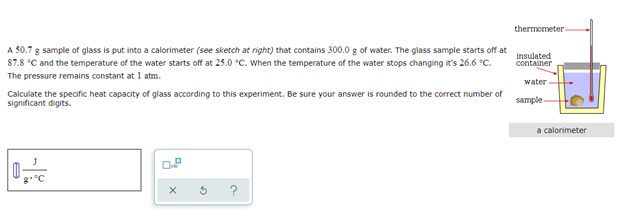A 50.7 g sample of glass is put into a calorimeter (see sketch at right) that contains 300.0 g of water. The glass sample starts off at 87.8 °C and the temperature of the water starts off at 25.0 °C. When the temperature of the water stops changing it's 26.6 °C. The pressure remains constant at 1 atm. Calculate the specific heat capacity of glass according to this experiment. Be sure your answer is rounded to the correct number of significant digits. e X 2 2 insulated container water sample a calorimeter
A 50.7 g sample of glass is put into a calorimeter (see sketch at right) that contains 300.0 g of water. The glass sample starts off at 87.8 °C and the temperature of the water starts off at 25.0 °C. When the temperature of the water stops changing it's 26.6 °C. The pressure remains constant at 1 atm. Calculate the specific heat capacity of glass according to this experiment. Be sure your answer is rounded to the correct number of significant digits. e X 2 2 insulated container water sample a calorimeter
Chemistry: Principles and Practice
3rd Edition
ISBN:9780534420123
Author:Daniel L. Reger, Scott R. Goode, David W. Ball, Edward Mercer
Publisher:Daniel L. Reger, Scott R. Goode, David W. Ball, Edward Mercer
Chapter5: Thermochemistry
Section: Chapter Questions
Problem 5.63QE: A 0.470-g sample of magnesium reacts with 200 g dilute HCl in a coffee-cup calorimeter to form...
Related questions
Question

Transcribed Image Text:A 50.7 g sample of glass is put into a calorimeter (see sketch at right) that contains 300.0 g of water. The glass sample starts off at
87.8 °C and the temperature of the water starts off at 25.0 °C. When the temperature of the water stops changing it's 26.6 °C.
The pressure remains constant at 1 atm.
Calculate the specific heat capacity of glass according to this experiment. Be sure your answer is rounded to the correct number of
significant digits.
e
D
X
G
thermometer
insulated
container
water
sample
a calorimeter
Expert Solution
This question has been solved!
Explore an expertly crafted, step-by-step solution for a thorough understanding of key concepts.
Step by step
Solved in 2 steps with 2 images

Knowledge Booster
Learn more about
Need a deep-dive on the concept behind this application? Look no further. Learn more about this topic, chemistry and related others by exploring similar questions and additional content below.Recommended textbooks for you

Chemistry: Principles and Practice
Chemistry
ISBN:
9780534420123
Author:
Daniel L. Reger, Scott R. Goode, David W. Ball, Edward Mercer
Publisher:
Cengage Learning

Chemistry: An Atoms First Approach
Chemistry
ISBN:
9781305079243
Author:
Steven S. Zumdahl, Susan A. Zumdahl
Publisher:
Cengage Learning

Chemistry
Chemistry
ISBN:
9781305957404
Author:
Steven S. Zumdahl, Susan A. Zumdahl, Donald J. DeCoste
Publisher:
Cengage Learning

Chemistry: Principles and Practice
Chemistry
ISBN:
9780534420123
Author:
Daniel L. Reger, Scott R. Goode, David W. Ball, Edward Mercer
Publisher:
Cengage Learning

Chemistry: An Atoms First Approach
Chemistry
ISBN:
9781305079243
Author:
Steven S. Zumdahl, Susan A. Zumdahl
Publisher:
Cengage Learning

Chemistry
Chemistry
ISBN:
9781305957404
Author:
Steven S. Zumdahl, Susan A. Zumdahl, Donald J. DeCoste
Publisher:
Cengage Learning


Chemistry & Chemical Reactivity
Chemistry
ISBN:
9781337399074
Author:
John C. Kotz, Paul M. Treichel, John Townsend, David Treichel
Publisher:
Cengage Learning

Chemistry & Chemical Reactivity
Chemistry
ISBN:
9781133949640
Author:
John C. Kotz, Paul M. Treichel, John Townsend, David Treichel
Publisher:
Cengage Learning